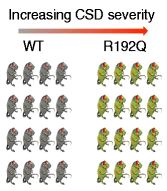 Ricardo J. Carreira, Reinald Shyti, Benjamin Balluff, Walid M. Abdelmoula, Sandra H. van Heiningen, Rene J. van Zeijl, Jouke Dijkstra, Michel D. Ferrari, Else A. Tolner, Liam A. McDonnell and Arn M. J. M. van den Maagdenberg
Ricardo J. Carreira, Reinald Shyti, Benjamin Balluff, Walid M. Abdelmoula, Sandra H. van Heiningen, Rene J. van Zeijl, Jouke Dijkstra, Michel D. Ferrari, Else A. Tolner, Liam A. McDonnell and Arn M. J. M. van den Maagdenberg
J Am Soc Mass Spectrom. 2015 Jun;26(6):853-61. Epub 2015 Apr 16.
Cortical spreading depression (CSD) is the electrophysiological correlate of migraine aura. Transgenic mice carrying the R192Q missense mutation in the Cacna1a gene, which in patients causes familial hemiplegic migraine type 1 (FHM1), exhibit increased propensity to CSD. Herein, mass spectrometry imaging (MSI) was applied for the first time to an animal cohort of transgenic and wild type mice to study the biomolecular changes following CSD in the brain. Ninety-six coronal brain sections from 32 mice were analyzed by MALDI-MSI. All MSI datasets were registered to the Allen Brain Atlas reference atlas of the mouse brain so that the molecular signatures of distinct brain regions could be compared. A number of metabolites and peptides showed substantial changes in the brain associated with CSD. Among those, different mass spectral features showed significant (t-test, P < 0.05) changes in the cortex, 146 and 377 Da, and in the thalamus, 1820 and 1834 Da, of the CSD-affected hemisphere of FHM1 R192Q mice. Our findings reveal CSD- and genotype-specific molecular changes in the brain of FHM1 transgenic mice that may further our understanding about the role of CSD in migraine pathophysiology. The results also demonstrate the utility of aligning MSI datasets to a common reference atlas for large-scale MSI investigations.


No responses yet